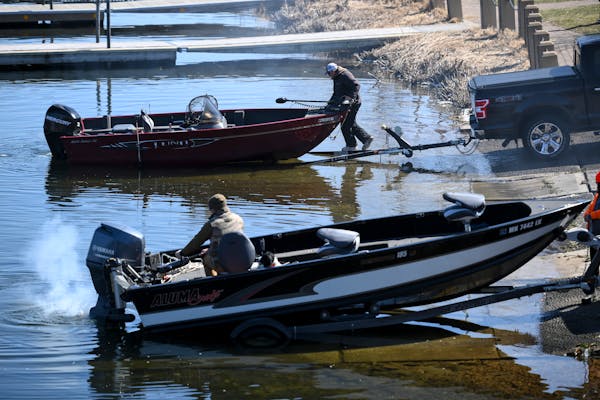You remember invasive carp, right? Scary critters with fins that are swimming up the Mississippi River toward Minnesota? Some are called grass carp, others bighead carp or black carp,
And the really awful, jumping carp? They're silver carp.
Silvers are the ones that have already populated rivers throughout the nation's midsection. The Illinois. The Ohio. The Wabash.
These and a few score other U.S. waterways are rife with silvers — fish that can leap from the water by the hundreds when they hear the whine of a boat motor.
Quiet cruises on those rivers? They're gone for the most part, replaced by fish-dodging survival sprees. Gone for the most part also are recreational options such as water skiing, or even running from one fishing spot to another without anglers worrying they'll be whacked in the noggin by a silver carp.
Silver carp also play havoc with native ecosystems, displacing both game and non-game fish.
No one can blame you if you've forgotten about these loathsome invaders, because the Department of Natural Resources (DNR) also seems to have relegated their threat to the back burner — and the burner behind that one, too.
If you doubt that, check out this from the agency's website:
"The Minnesota DNR has been working to slow the spread of invasive carp since the early 2000s. A renewed effort began in 2011 and a collaboration of state and federal agencies, conservation groups and university researchers developed the Minnesota Invasive Carp Action Plan.''
Now, 12 years after that plan was formulated, instead of requesting money this session from the Legislature to install a Mississippi River deterrent that could minimize the chances silver carp can establish breeding populations that threaten more state waters, the DNR wants to ... wait for it ... form a committee to talk things over.
This "deliberative decision-making process" will take four to six months.
All well and good, says the conservation organization Friends of the Mississippi River (FMR). Though the group will be part of the talks, it is pressing ahead this legislative session for funding to install a bubble and sound deterrent at Lock and Dam 5 on the Mississippi, located in Winona County near Minnesota City — a placement recommended by University of Minnesota professor and researcher Peter Sorensen.
"Ideally this funding would have been achieved two years ago,'' said FMR executive director Whitney Clark. "Even with divided government and tighter budgets in recent years, I think we could have gotten the money from the Legislature for the deterrent if the DNR had been ready.
"Now, with the state in a better financial situation, we think this is an opportune moment to get the deterrent funded and to work toward protecting Minnesota waters from invasive carp.''
At the U, Sorensen's research has included control of sea lampreys in the Great Lakes and, more recently, control of both common carp and their invasive counterparts, all of which are part of his broader academic interest in fish physiology and behavior.
Sorensen has been at the forefront of carp control in Minnesota and nationally for decades, and in his lab at the U has researched ways to stop silver and other invasive carp from reaching the Upper Mississippi River, as well as the Minnesota and St. Croix rivers.
Much of his work has been funded by Minnesota lottery money as recommended by the Legislative-Citizen Commission on Minnesota Resources (LCCMR).
In his lab, Sorensen and his students have tested a commercially available bubble and sound deterrent in a simulated river that is 30 feet long and 10 feet wide.
Thousands of fish were released over five years in the "river,'' to see whether they could breach the barrier.
"We found the deterrent was 95 to 98% effective, which is about as much as you could hope for,'' Sorensen said. "That would be enough to keep breeding populations from getting through the lock and dam, which is the goal.''
Upstream on the Mississippi from where Sorensen proposes to install the deterrent are confluences with the Minnesota River, which runs west to the South Dakota border, and the St. Croix River, which flows unimpeded to the dam at Taylors Falls.
At risk as well are Lake Pepin, Wisconsin's Chippewa River and various Mississippi River pools, including Pool 2, which offers some of the metro's, and state's, best year-round walleye, sauger, and bass (smallmouth and largemouth) fishing.
The best available deterrent, Sorensen believes, is a bio-acoustic fish fence (BAFF) developed by a British company, Fish Guidance Systems.
"We believe the BAFF system, which already has been installed below a lock and dam in Kentucky, and is working effectively, is our best choice,'' he said.
Clark of FMR agrees.
"We think the time is now," he said. "We wish the DNR had included money for the barrier in their budget requests to the Legislature this year, but they didn't. So we are having a bill introduced that, if passed, will allot $17 million for the barrier, as well as carp removal near the deterrent site, and development of a native fish passage system. The money could come from the budget surplus or from bonding."
Installation of the deterrent could take two to three years, Sorensen said, adding that leasing the system initially might be best.
"If we act now, I think we can protect our waters at least through the lives of our grandchildren," Sorensen said. "If we don't act and breeding populations take hold, particularly of silver carp, we know of no way to get rid of them."

Anderson: Celebrate Earth Day by rekindling real connection to nature
Anderson: Anglers protesting tough new Mille Lacs rules are wrong

Anderson: Courts, not politicians, should rule on Red Lake, White Earth lands

Anderson: Multimillion windfall gets invasive carp deterrent moving
![A young whitetail deer searches for food as another blanket of snow coats the arrowhead. ] Minnesota -State of Wonders, Arrowhead in Winter BRIAN PETE](https://arc.stimg.co/startribunemedia/WK32UWWY6FKNWJUIYCJ6ZPT4AU.jpg?h=91&w=145&fit=crop&bg=999&crop=faces)



